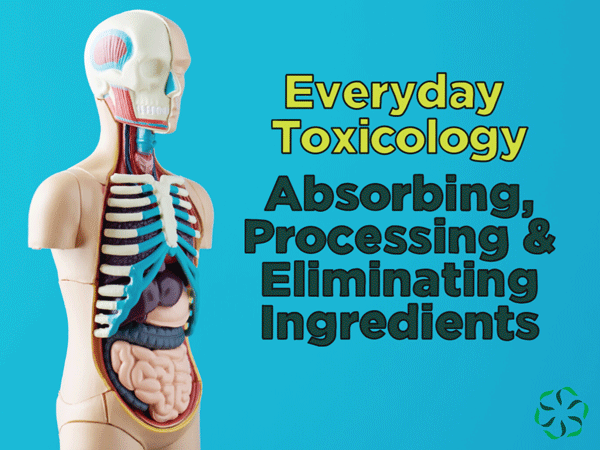Our bodies absorb, process, and eliminate ingredients and toxins regularly. In this post, we’ll explore how our bodies process ingredients every day in many different ways.
How do ingredients get into our bodies?
As we’ve discussed, there are different exposure routes that allow our bodies to come into contact with chemicals such as nutrients, including vitamins, proteins, and more (remember, everything is a chemical).
These routes of exposure include our digestive tract through eating and drinking, respiratory tract by breathing, and topically via our skin. They control what key ingredients make their way into our system by acting as a filter and aiding in the absorption process.
These highly specialized systems differentiate between ingredients that can be absorbed and processed by the body, and ingredients the body should eliminate. For example, our digestive tract will absorb a carrot’s nutrients while allowing the ingestible fiber to pass safely through our digestive system.
However, these systems cannot always differentiate between helpful and harmful ingredients. For example, the body may not be able to distinguish between a toxin and a nutrient since they both can be absorbed. Just as the body may not be able to stop absorbing too much of a beneficial ingredient that can eventually lead to harm. That is why the dose and dose-rate are critical to maintaining health.
What happens after ingredients are absorbed in the body?
After absorption, ingredients will move throughout the body via the bloodstream to the needed area. For example, the digestive tract can absorb iodine from seafood we consume, the iodine will enter the bloodstream, and then the thyroid can use the iodine. The body will eliminate any unusable ingredients from the seafood.
What is elimination?
After our body uses vital nutrients found in the ingredients we consume, the byproducts are promptly eliminated from our body primarily through our digestive system.
Four vital organs help breakdown and facilitate the elimination process:
- Liver: The liver primarily processes nutrients to be used throughout the body and modifies toxicants, often making them more water-soluble, so they can be more easily eliminated from the body by the kidney.
- Kidneys: The kidneys mainly filter blood to help remove toxins and byproducts from the body via urine.
- Colon: The colon eliminates byproducts from the body via bowel movements.
- Lungs: The lungs eliminate airborne toxins via breathing.
How do these systems work together?
Our bodies depend on us consuming the proper quantities of specific ingredients (dose) at the correct intervals (dose-rate) through accessible routes (exposure routes) to absorb, process and then eliminate the byproduct from the body.
This goes for all the ingredients we consume from food to water to medication. Balance is key to the system working correctly.
Let’s take a look at how our system would process a medication.
Let’s look at acetaminophen.
If we have a fever, we may choose to use acetaminophen to decrease our temperature. We know that we need to take the correct dose at the correct dose-rate through the proper exposure route to ensure the medication works as intended.
Once we take the right dose via a pill or liquid orally, our body will take over processing the medication:
- Our digestive system will absorb the medication into our bloodstream.
- Our bloodstream will deliver the medication throughout the body.
- Essential organs will receive the medication that will help reduce fever.
- The liver will process the medication (via metabolism) into a form that can be filtered by the kidneys for elimination.
The above process works well if we take the proper dose at the appropriate dose-rate. However, if we take too much of the acetaminophen and/or take it at too high of a dose-rate, our body may be unable to eliminate the ingredient quickly enough, which can cause adverse health effects including liver injury.
What does this all mean?
Our bodies are capable of recognizing filtering, absorbing, processing, and eliminating ingredients from many different exposure routes. But, it’s up to us to make sure that we maintain a healthful balance when consuming different foods, medications, and more.

